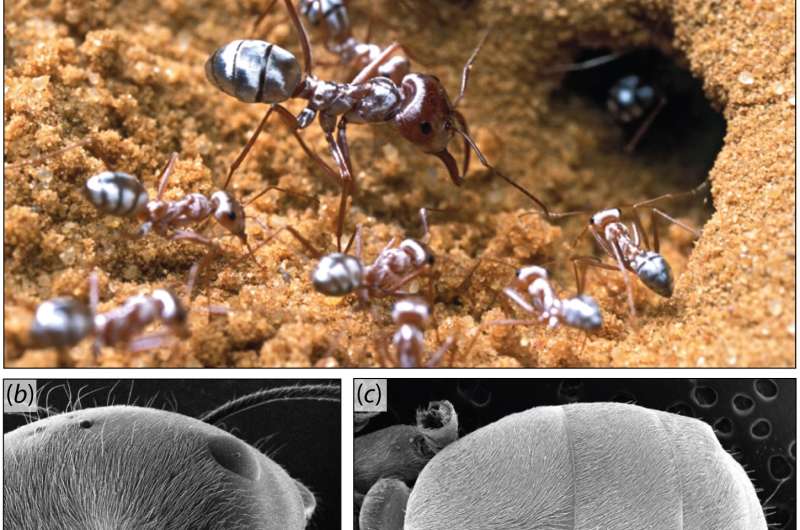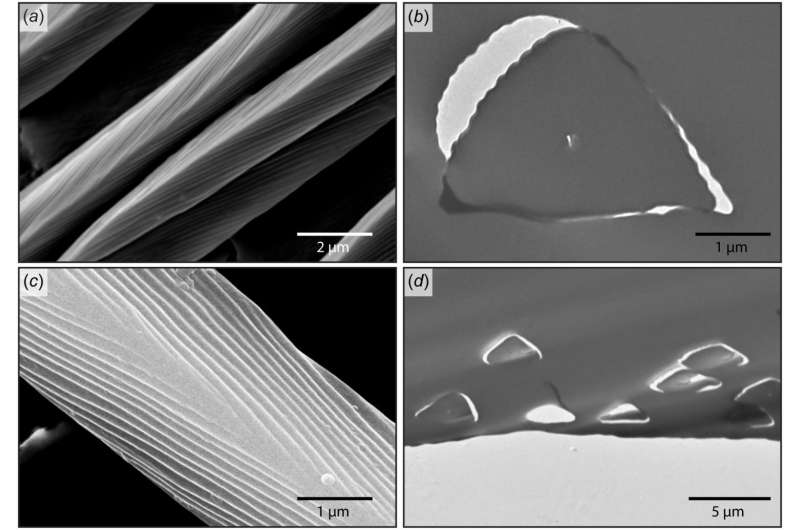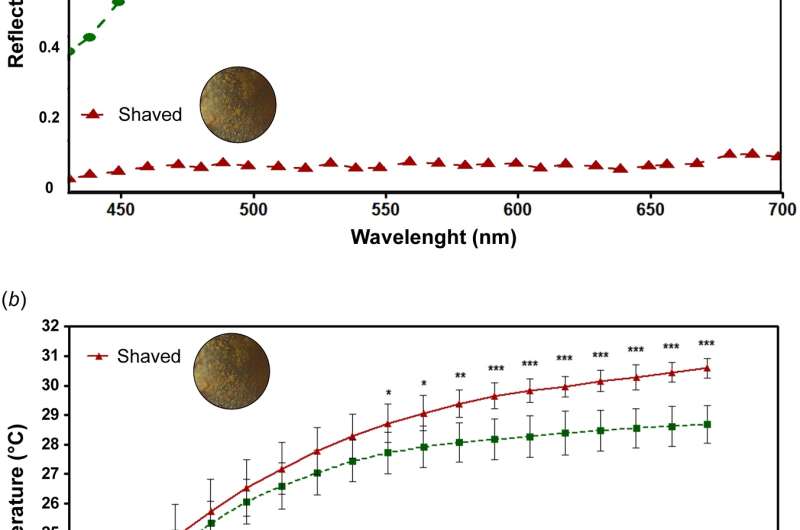The silver ant Cataglyphis bombycina.Colonies contain a caste of spindly workers and a caste of soldiers with large heads and saber-shaped mandibles. (a) In full sunlight, workers and soldiers show a metallic sheen that justifies the vernacular name of the species. (b,c) The hairs covering the dorsal side of the workers' head, thorax (b) and abdomen (c) follow the cuticle's curvatures. Credit: P. Landmann, Willot et al.
The body hairs of the Saharan silver ant cause total internal reflection of light to make the ants almost ten times more reflective, preventing overheating and yielding their silver sheen, according to a study published April 13, 2016 in the open-access journal PLOS ONE by Quentin Willot from the University Libre de Bruxelles, Belgium, and colleagues.
The Saharan silver ant is one of the terrestrial living organisms best-adapted for high temperatures, and can forage in the desert even when temperatures exceed 50 degrees Celsius. It has previously been shown that its dorsal body hairs are responsible for its silver color and help prevent overheating. However, the details of the hairs' optical properties had not been elucidated.
The authors of the present study used a Scanning Electron Microscope (SEM) to examine the ant hairs and trace the path of incoming light rays. They also compared normal 'hairy' ant samples with ants that had been shaved, measuring how light was reflected and how quickly ants heated under simulated sunlight.
The researchers found that hairy ants were almost ten times more reflective than shaved ants, and were able to stay up to 2 C cooler under simulated sunlight. They also confirmed that the triangular cross-section and corrugated surface of each hair act like a prism to reflect light, where the light rays entering each ant hair undergo total internal reflection, bouncing back off the bottom plane of the hair instead of transmitting through it. This mirror effect gives the ant its bright silver sheen and reduces heat absorption from sunlight, preventing the ant from overheating.
Electron microscopy images of the hairs covering the dorsal side of the body of C. bombycina.(a) Scanning electron microscopy (SEM) of the hairs covering the cuticle of ants. Hairs have a triangular shape and end in a sharp point. (b) Transmission electron microscopy (TEM) image of the cross-section of a hair. The two upper sides of the triangular shape are corrugated and the lower side (the triangle base) is flat. (c) Close up on the corrugations covering the two upper side of the triangular shape. (d) TEM image of hairs shows that they all adopt the same orientation, with their flat basal side parallel to each other and to the cuticle surface. The corrugated sides of the hairs are turned up as is clearly visible on image (a). Credit: Willot et al.
Most arthropods have cylindrical or plate-like body bristles, so these results may be specific to this ant species. However, the authors state that this study improves our understanding of the Saharan silver ant's unusual color and ability to survive in the desert heat.
Co-author Serge Aron notes, "The ability to reflect solar radiation by mean of total internal reflection is a novel adaptive mechanism in desert animals, which gives an efficient thermal protection against the intense solar radiation. To the best of our knowledge, this is also the first time that total internal reflection is shown to determine the color of an organism."
Reflectance and heating curves of hairy workers and shaved workers of C. bombycina.(a) Reflectance. TIR is induced on the ant abdomen with an incident light at 50° and azimuth 0. Reflectance is about 10-fold higher in the presence of hairs, for wavelengths ranging from 425 to 700 nm. (b) Heating curves. Abdomens are exposed for 90 seconds to the light emitted by a solar simulator whose visible spectral intensity is identical to the summer Saharan sun. Difference in excess temperature becomes significant after 45 seconds; after 90 seconds exposure, the difference in excess temperature between both conditions reaches 1.91°C. Unpaired Student t-test (*: p < 0.05, **: p < 0.01, ***: p < 0.001). Credit: Willot et al.
More information: Willot Q, Simonis P, Vigneron J-P, Aron S (2016) Total Internal Reflection Accounts for the Bright Color of the Saharan Silver Ant. PLoS ONE 11(4): e0152325. DOI: 10.1371/journal.pone.0152325
Journal information: PLoS ONE
Provided by Public Library of Science

























